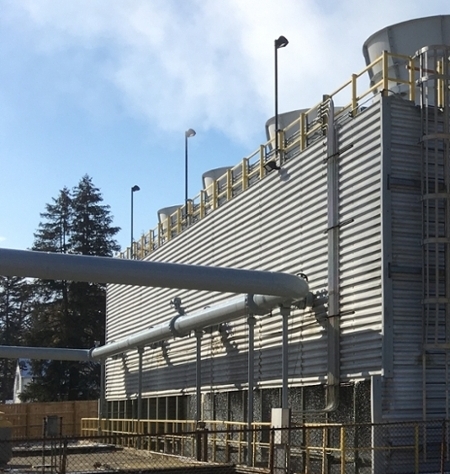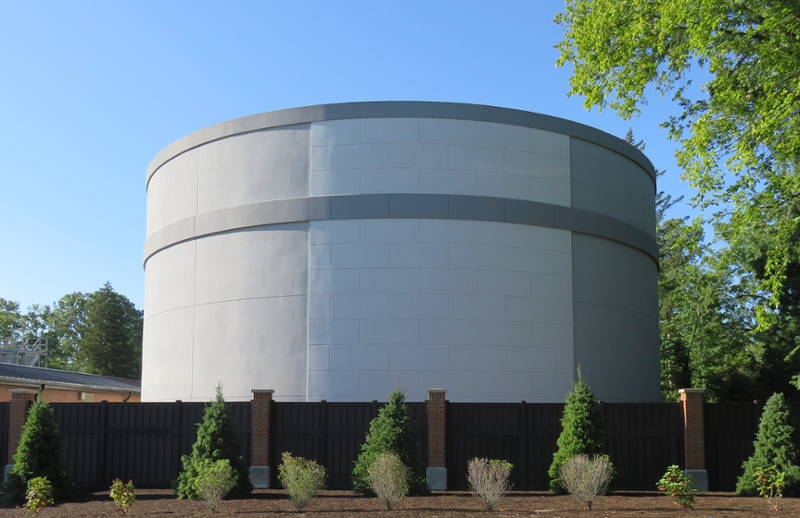
Moving off steam: Utility Master Plan provides a path toward carbon neutrality
Miami’s campus conversions reduce energy use, cost and carbon footprint
By Susan Meikle, university news and communications
Just nine years ago nearly all of Miami University's Oxford campus buildings were heated by carbon-intensive steam.
Today, just under half (49%) of those buildings are heated by steam.
The physical facilities' energy systems office, directed by Doug Hammerle, has done more in 2018-2019 than in any other year on conversions of energy systems throughout campus. These conversions have reduced energy use and energy costs, and increased energy efficiency.
By 2026, thanks to Miami's Utility Master Plan, the central steam plant will be converted to Heating Hot Water (HHW). By then, nearly all buildings will be off steam and heated and cooled by geothermal energy, Simultaneous Heat and Cooling or HHW.
The South Campus Chiller plant provides Heating Hot Water to 19 buildings on South Quad, including the recreational sports center, Goggin Ice Center and Phillips Hall.
Why does this matter?
Moving to electric-based power provides a path towards carbon neutrality
Converting campus energy systems away from fossil-fuel-powered steam to systems that are powered by electricity increases the opportunities to purchase renewable electricity off the grid, such as wind or solar power.
Adam Sizemore, director of sustainability, said "This work is necessary in order to achieve a carbon neutral campus."
Cody Powell, associate vice president for facilities planning and operations, said that these energy systems conversions have been accomplished without any dedicated funding for these outcomes.
Through "extremely effective comprehensive planning and working towards our sustainability goals through integrated master planning, the office of energy systems has transformed how our utilities are delivered without major disruptions on campus or duplicate construction costs," Powell said.
According to Hammerle, no other peer university (other than Ball State University, with the largest geothermal system in the country) has done such a complete transition away from carbon-based steam to electric-based heating and cooling.
- In addition to moving to less carbon-intensive power, energy efficiency has increased: total energy use, kBtu/GSF (kilo British thermal units/gross square feet), from 2008 to 2019 decreased 39%, even though the total campus GSF increased by 25%.
Other outcomes include:
- Cost savings: energy, chemicals, regulatory compliance costs.
- Saving water: 43% reduction (projected) in water use; millions of gallons saved/year.
- Productivity and safety increases.
- Customer satisfaction (i.e. individual room temperature control).
Energy systems conversion 2018-2019 highlights
The new 1.6 million gallon thermal energy storage tank at the South Chiller plant.
Centered on South Quad, more work was done this past year than in any other year on conversions of energy systems throughout campus.
1. Nineteen buildings on South Quad were converted from steam to Heating Hot Water/Simultaneous Heating and Cooling. Buildings included residence halls, the recreational sports center, Phillips Hall and Goggin Ice Center.
2. The new 1.6 million gallon thermal energy storage (TES) tank at the South Campus Chiller Plant.
3. Conversions at Goggin Ice Center significantly increased energy efficiency: The new heat recovery system recaptures up to 1.8 million Btus of heat from the ice plant and injects it back into the building's HHW loop. About 75% of the heat used from cooling the ice used to be wasted, but is now returned to the HHW loop, Hammerle said. This system, plus the new HP chiller also installed in the ice plant, will save about $300,000 in utility costs annually, he said.
Refer to the tables below for data on the campus conversions off steam, energy use and carbon emissions reductions, and past and projected timelines.
|
Heating Energy Type |
Number of Buildings |
Percent of Buildings |
Gross Square Feet (GSF)** |
|---|---|---|---|
| Steam | 89 | 93% | 5,947,290 |
| Stand Alone* | 19 | 7% | 413,537 |
| HHW | 0 | 0 | 0 |
| HW/SHC | 0 | 0 | 0 |
| Geothermal | 0 | 0 | 0 |
| Total | 108 | 6,360,827 |
|
Heating Energy Type |
Number of Buildings |
Percent of Buildings |
Gross Square Feet (GSF)** |
|---|---|---|---|
| Steam | 54 | 49% | 3,565,595 |
| Stand Alone* | 19 | 6% | 413,537 |
| HHW | 0 | 0 | 0 |
| HW/SHC | 35 | 37% | 2,716,037 |
| Geothermal | 13 | 8% | 613,163 |
| Total | 121 | 7,308,332 |
|
Heating Energy Type |
Number of Buildings |
Percent of Buildings |
Gross Square Feet (GSF)** |
|---|---|---|---|
| Steam | 2 | 4% | 323,942 |
| Stand Alone* | 19 | 6% | 413,537 |
| HHW | 16 | 14% | 978,270 |
| HW/SHC | 41 | 37% | 2,730,838 |
| Geothermal | 43 | 39% | 2,852,745 |
| Total | 121 | 7,308,332 |
*Two buildings, Hughes Laboratories and the psychology building, will remain on steam for scientific equipment and humidification needs. Stand-alone buildings generate their heating or cooling within their buildings (i.e. from a boiler or chiller) instead of from a central source.
**GSF is based on contiguous buildings on the Oxford campus tied into the central distribution system.
|
Year |
Energy Use KBTU/GSF |
Energy Use % Reduction |
Carbon Emissions % Reduction |
Carbon Emissions % Reduction/GSF |
Energy Cost/GSF |
|---|---|---|---|---|---|
| 2008 | 165.8 | $1.25 | |||
| 2019 | 100.9 | 39% | 45% | 33% | $0.81 |
| 2026 | 75.6 | 54% | 51% | 43% | $0.69 |
Moving to electric-based heating/cooling reduces fossil fuel use. The table below shows the reduction of fossil fuel contributions to total carbon emissions (converted to metric tons carbon dioxide equivalent, MTCO2e).
|
Year |
Electric (MTCO2e) and % Change |
Fossil Fuel (MTCO2e) and % Change |
Water Use Central Plant (gallons) |
|---|---|---|---|
| 2019 | 57,657 | 25,424 | 42,000,000 |
| 2026 |
61,870 +7% |
14,719 -42% From 2008 Baseline: -74% |
24,000,000 -43% use from 2019 |
How did we get here? Long-range planning and opportunities for change
- Miami's first Sustainability Commitments and Goals developed in 2010 presented an opportunity for change, according to Powell.
- Around the same time, Miami's Long Range Housing and Dining Plan (2010) and nationally-recognized Stormwater Master Plan (2011) were also developed.
- Hammerle and Powell took the opportunity, and risk, to plan for a major geothermal heating and cooling system. It has since become the largest geothermal system among Ohio colleges and universities.
- Their plan became the Utility Master Plan (UMP), approved in 2012. It was updated in 2017 to plan for moving off steam.
UMP Projects 1-3, Completed
- 2012-2016: Project 1 — Western Campus Geothermal Infrastructure, phase 1 & 2.
- 2013-2015: Project 2 — North Chiller Plant and East Quad infrastructure/renovations.
- 2018-2019: Project 3 — South Quad Heating Hot Water conversion, Goggin Ice Center, South Chiller Plant conversion and Thermal Energy Storage tank.
Next Steps: UMP Projects 4-7, 2020-2026
- 2020-2022: Project 4 — Central Quad HHW conversion phase 1, 2, 3.
- 2024: Project 5 — Expand Western Geothermal to all Western campus buildings.
- 2025: Project 6 — North Chiller conversion to Geothermal (new well field under Millett parking lot).
- 2026: Project 7 — Steam Plant conversion to HHW.
With this, Miami will be able to move closer to carbon neutrality, through the possibility of purchasing renewable electricity off the grid.

